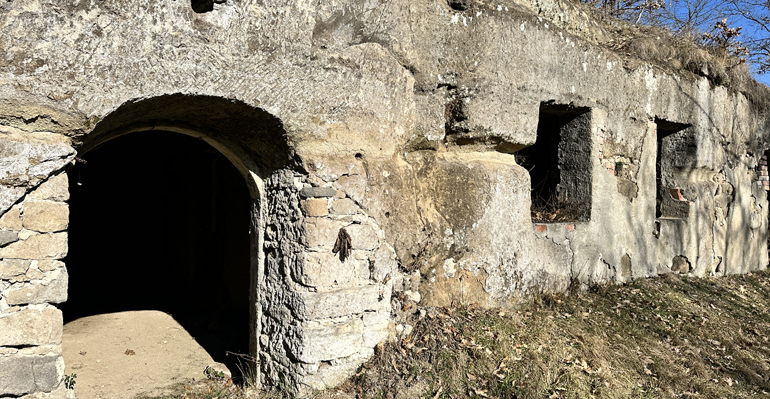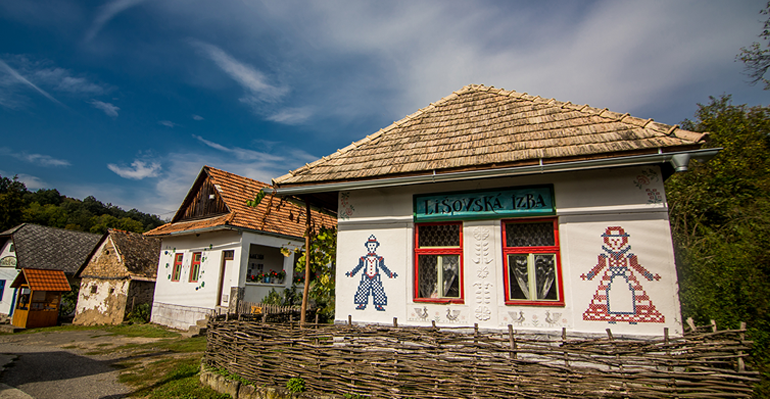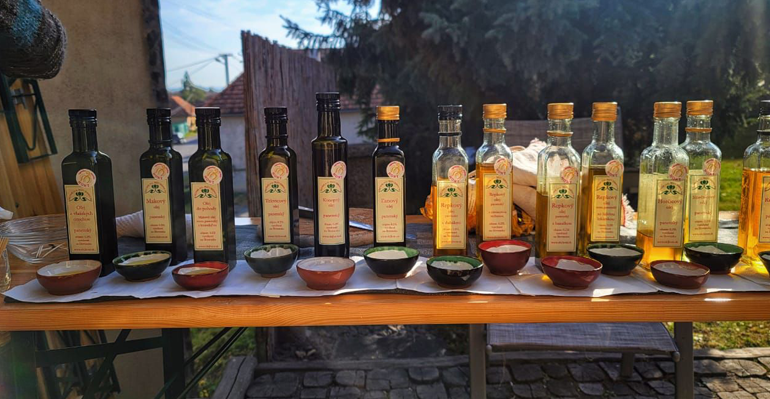
Whispers of Stone – The Hidden Cave Dwellings of Lišov
Introduction:
In the southernmost reaches of the Štiavnica Hills, the village of Lišov holds a remarkable piece of Slovakia’s cultural heritage – a network of cave dwellings carved by hand into volcanic tuff. These structures, estimated at around 250 in number, represent a unique form of folk architecture, shaped by both necessity and ingenuity.
Their origins date back to the 15th and 16th centuries, when they were likely used as hiding places during Turkish invasions. However, some may be even older, as Lišov's history reaches as far back as the Neolithic period. Evidence of the Lengyel culture (3200-2900 BCE) has been found in the area, including some of the first copper tools discovered in Slovakia. Later, during the Bronze Age, the region was home to the Lusatian culture, leaving behind ceramic artifacts now housed in the Slovak National Museum.
Throughout history, Lišov’s cave dwellings served multiple purposes – some as homes, others as cellars for storing wine and food. Wealthy nobles, landowners, and merchants from royal mining towns like Banská Štiavnica, Kremnica, and Banská Bystrica built extensive cave complexes, often inscribing their names in local vineyard records or even directly onto the cave walls.
From the noble cellars of Drieňovské, where wine aged in the cool stone, to the humble caves of Dolné Brehy, where villagers lived in close harmony with nature, these dwellings tell a forgotten story of resilience, craftsmanship, and adaptation to the land.
What you'll discover:
Drieňovské Cave Houses
Once part of noble estates, these grand stone dwellings housed vineyard caretakers and stored valuable wine for the aristocracy.
Podsazenské Cave House
A shoemaker’s refuge, where life continued even as the world outside changed.
Dolné Brehy Cave House
The home of a herbalist and healer, who lived in harmony with nature, gathering remedies from the land.
Each stop on this trail offers a glimpse into a different way of life – from medieval nobility to humble villagers, from skilled craftsmen to those who understood the secrets of the forest.
Why this trail matters:
These cave dwellings are not just historical sites – they are living stories. They reveal how people adapted to their environment, using the land not just to survive, but to build a community, a culture, and a way of life.
In an age where modernity has erased many old traditions, these caves stand as a reminder of a time when humans and nature worked together in balance.
Heritage Trail Map:
Heritage Trail Details:
- Length (km): 4,5km
- How it could be undertaken: walking, cycling
- Starting point: Lišov Múzeum https://maps.app.goo.gl/dtR3ZG6kWYBDXfbc8)
- Duration:
- If you undertake the quests at the cave houses, you will need 1,5 hours to complete the trail
- If you don’t, visiting the cave houses will take you 1 hour
- Special notes (clothes, equipment, weather, etc.):
- Sturdy shoes (rocky terrain inside caves and slippery paths in the forest)
- Flashlight or headlamp (low-light areas inside caves)
- Smartphone or printed map (for navigation)
- Notebook or phone (to take notes for clues, if you engage with quests)
- Field guide or phone app for plant identification (if you engage with the quest in the Dolné Brehy Cave House)
- Best Season: Spring to Autumn (April – October), when the caves are easily accessible and safe
- Safety guidelines:
- Be cautious of uneven surfaces in the caves
- Do not enter areas marked as private property
- Watch for loose rocks or slippery surfaces
- Limited mobile coverage inside the caves – download an offline map
- Some sections of the cave houses are fragile – do not touch the walls excessively
- Respect the sites – the cave houses are cultural heritage
- Guiding:
- This trail can be undertaken by travelers on their own
- Guiding is not offered
- Contacts for more details:
- Lišov Múzeum
- https://lisovmuzeum.sk/
- Lisov 15 96271 Lisov
- +421 902 324 577
Quests / Chances to be creative:
Quest 1: 'The Guardian of the Noble Cellars'
- Theme & Heritage Focus: Medieval wine-making, noble estates, and underground storage in the Drieňovské Cave Houses
- Duration: 30-45 minutes
- Difficulty Level: Moderate (some uneven terrain and cave exploration)
- Location: Drieňovské Cave Houses (https://maps.app.goo.gl/TmsRHXEh5wPbf9ba8)
- Best Season: Spring to Autumn (April – October), when the caves are accessible and safe
Mission
You are a medieval vineyard caretaker, entrusted with guarding the noble’s most valuable treasure – his wine. Your task is to navigate the Drieňovské Cave Houses, uncover clues about how the wine was stored, and ensure the barrels remain safe from thieves and spoilage.
Challenge
- Inspect the ancient wine cellars
- Decipher how medieval winemakers protected their stock
- Solve a puzzle about wine storage methods
Starting Point
Entrance to Drieňovské Cave Houses (look for the stone arch).
Area Description
Two large cellar chambers, carved rooms, smokehouse, and storage areas.
Success Criteria
To complete the challenge, you should find three key inscriptions inside the cave cellars, revealing the secret to medieval wine storage.
Quest 2: 'The Shoemaker’s Legacy'
- Theme & Heritage Focus: Craftsmanship and everyday life in the Podsazenské Cave House
- Duration: 20-30 minutes
- Difficulty Level: Easy
- Location: Podsazenské Cave House (https://maps.app.goo.gl/FkeZWaXe5nvBNnr89)
- Best Season: Year-round
Mission
Step into the shoes of the last shoemaker from Podsazenské cave house Selecéni. Your task is to reconstruct his lost craft by identifying key objects inside his workshop and solving a mystery about the tools he left behind.
Challenge
Your goal is to identify three essential tools of the shoemaker hidden inside the Podsazenské Cave House and piece together how he lived and worked.
Starting Point
The entrance to the shoemaker’s cave (look for the small rock doorway).
Area Description
A single-room workshop, where Selecéni shaped leather shoes for the villagers. His workbench, sleeping area, and stone-carved storage remain inside.
Success Criteria
Find and document the three most important objects inside Selecéni’s workshop and explain how they were used.
Quest 3: 'The Herbalist’s Secret'
- Theme & Heritage Focus: Traditional herbal medicine, rural self-sufficiency, and nature’s wisdom in the Dolné Brehy Cave House
- Duration: 40-50 minutes
- Difficulty Level: Moderate (forest path and cave area)
- Location: Dolné Brehy Cave House (https://maps.app.goo.gl/ZyctnL8tNw7BkLV57)
- Best Season: From the spring to autumn.
Mission
You are an apprentice herbalist, following the footsteps of Tetka Filipka. Your quest is to explore the forests of Dolné Brehy, identify five medicinal plants, and recreate one of Tetka Filipka’s healing recipes.
Challenge
Your challenge is to identify five key medicinal plants near the cave house and match them to their historical uses, just as Tetka Filipka once did.
Starting Point
The entrance to the Dolné Brehy cave (marked by a small clearing).
Area Description
A forest-covered hillside, filled with wild herbs and flowers. The cave itself has a black kitchen, where herbs were once dried.
Success Criteria
Find, name, and describe five local medicinal plants, and identify which one was used in a traditional healing tea.

